
A Comprehensive Guide to the Direct Disposition Process
Understanding What Direct Disposition Really Means
Direct disposition refers to the immediate burial or cremation of a deceased person without traditional funeral services, embalming, or viewing ceremonies. This streamlined approach has become increasingly popular, with cremation rates (including direct cremation) now chosen by over 57% of families in North America.
Key Facts About Direct Disposition:
- Definition: Burial or cremation immediately following death with no body preparation or viewing
- Timeline: Typically completed within 24-48 hours or a few days after death
- Cost: 40-60% less expensive than traditional funeral services
- Providers: Funeral homes, cremation societies, and direct disposal facilities
- Common Types: Direct cremation and direct burial
- Memorial Options: Families can hold separate celebration of life services at any time
The shift toward direct disposition reflects changing attitudes about end-of-life care. When it comes to end-of-life arrangements, cremation is steadily becoming a preferred choice for numerous families and individuals. Many families appreciate the simplicity, affordability, and flexibility that direct disposition offers.
Religious requirements, budget constraints, and minimal family connections are the most common reasons families choose this option. However, the decision requires careful consideration of legal requirements, family dynamics, and emotional needs.
As Mortuary Cooler with years of experience in mortuary equipment supply, I've seen how proper refrigeration and storage are critical components of the direct disposition process. My expertise in mortuary coolers has shown me that maintaining dignity and respect during direct disposition requires the right equipment and procedures.
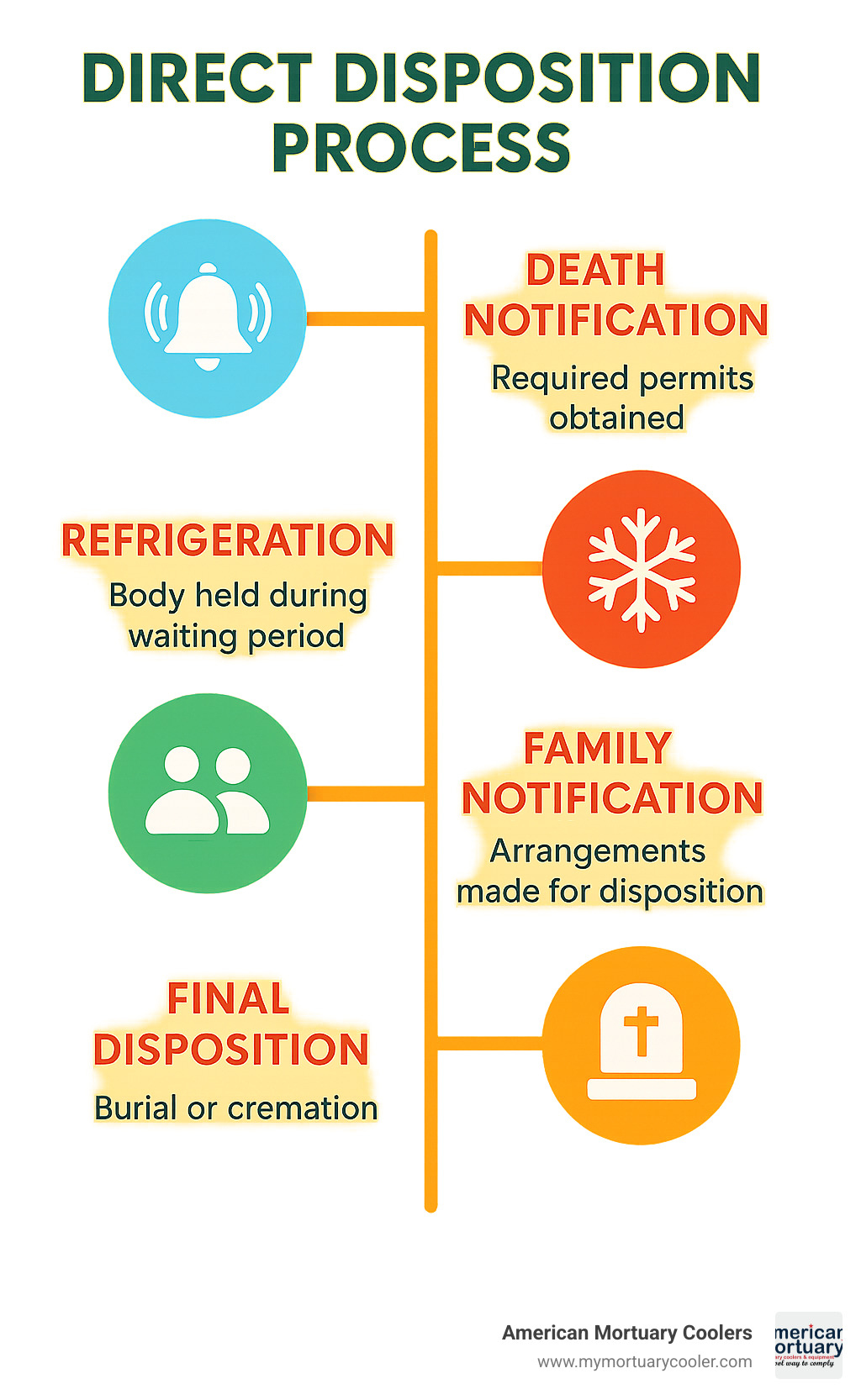
Key terms for direct disposition:
Understanding the Legal Foundations of Direct Disposition
When it comes to direct disposition, the law doesn't mess around. While the process itself is straightforward, there's a solid legal framework underneath that keeps everything running smoothly and protects everyone involved.
Think of it this way: the legal foundation is like the foundation of a house. You might not see it, but without it, everything falls apart. The good news? Once you understand the basics, navigating the legal side becomes much easier.
What the Law Means by "Direct Disposition"
In funeral and estate law, "disposition" is the official term for what happens to someone's remains after they pass away. It covers burial, cremation, donation to science, or any other legal method of final care.
Direct disposition takes this one step further. It's the legal term for immediate handling of the body without any of the traditional extras. No public visitation, no embalming, no formal ceremonies before the final process. Just respectful, dignified care that gets straight to the point.
Each state has its own rules about what makes a disposition legal. New York's estate law, for example, defines disposition as any transfer of property or remains, whether through burial, cremation, donation, or other approved methods. The key word here is "approved" - states want to make sure everything is done properly and safely.
Who Can Authorize a Direct Disposition?
Here's where things get important: not everyone can make decisions about direct disposition. The law is very clear about who gets to call the shots, and it follows a specific order of priority.
The Person Authorized to Direct Disposition (PADD) is often the most important role, especially for military families. This person is specifically designated on forms like the DD Form 93 and has the legal authority to make all final arrangements.
Spouses or domestic partners typically have first priority when there's no PADD designated. Adult children come next if there's no surviving spouse or partner. Then it moves down the family tree to parents, siblings, and other relatives in descending order.
Sometimes an executor or designated agent can step in if they've been named in legal documents like a will or advance directive. This is especially common when someone has planned ahead and wants specific arrangements carried out.
Military families have some unique considerations here. Service members can designate their preferred decision-maker and may have special benefits and reimbursements available for authorized expenses.
Required Documents & Permits
Every direct disposition needs proper paperwork - there's just no way around it. The specific documents vary by state, but some are required everywhere.
The death certificate is your starting point. This official record of death is required in every state and for every type of disposition. Burial-transit permits authorize the transport and final disposition of remains. For cremation, you'll need a cremation authorization form signed by the legal next of kin or authorized agent.
Some states require additional disposition permits for alternative methods like alkaline hydrolysis or human composting. These newer options are becoming more available, but they often have extra paperwork requirements.
The timing and specific requirements can vary quite a bit from state to state. California requires a 24-hour waiting period before cremation can take place. Florida extends this to 48 hours. Texas doesn't have a waiting period, but they have their own specific authorization forms. New York gives executors the power to override next-of-kin decisions in certain situations.
| State | Required for Burial | Required for Cremation | Special Requirements |
|---|---|---|---|
| California | Death certificate, permit | Death certificate, permit | 24-hr waiting period for cremation |
| Texas | Death certificate, burial permit | Death certificate, cremation auth | None |
| New York | Death certificate, transit permit | Death certificate, cremation auth | Executor can override next-of-kin |
| Florida | Death certificate, permit | Death certificate, permit | 48-hr waiting period for cremation |
The best advice? Always check with your local authorities or funeral provider for the most current requirements. Laws change, and what worked in one state might not fly in another. A good funeral director or direct disposition provider will handle most of this paperwork for you, but it's smart to understand what's happening behind the scenes.
Choosing the Right Form of Direct Disposition: Options & Providers
The term direct disposition encompasses several methods, each with unique features, providers, and costs.
Direct Cremation — The Fastest-Growing Choice
Direct cremation is the most popular form of direct disposition. It involves:
- Transporting the deceased directly to a crematory
- Completing the cremation without embalming or public viewing
- Returning the ashes (cremated remains) to the family in a basic container or urn
Why is direct cremation so popular?
- Affordability: Often 40-60% less expensive than a traditional funeral with burial.
- Speed: The process is typically completed within a few days or even hours of death.
- Flexibility: Families can hold memorial services later, on their own terms.
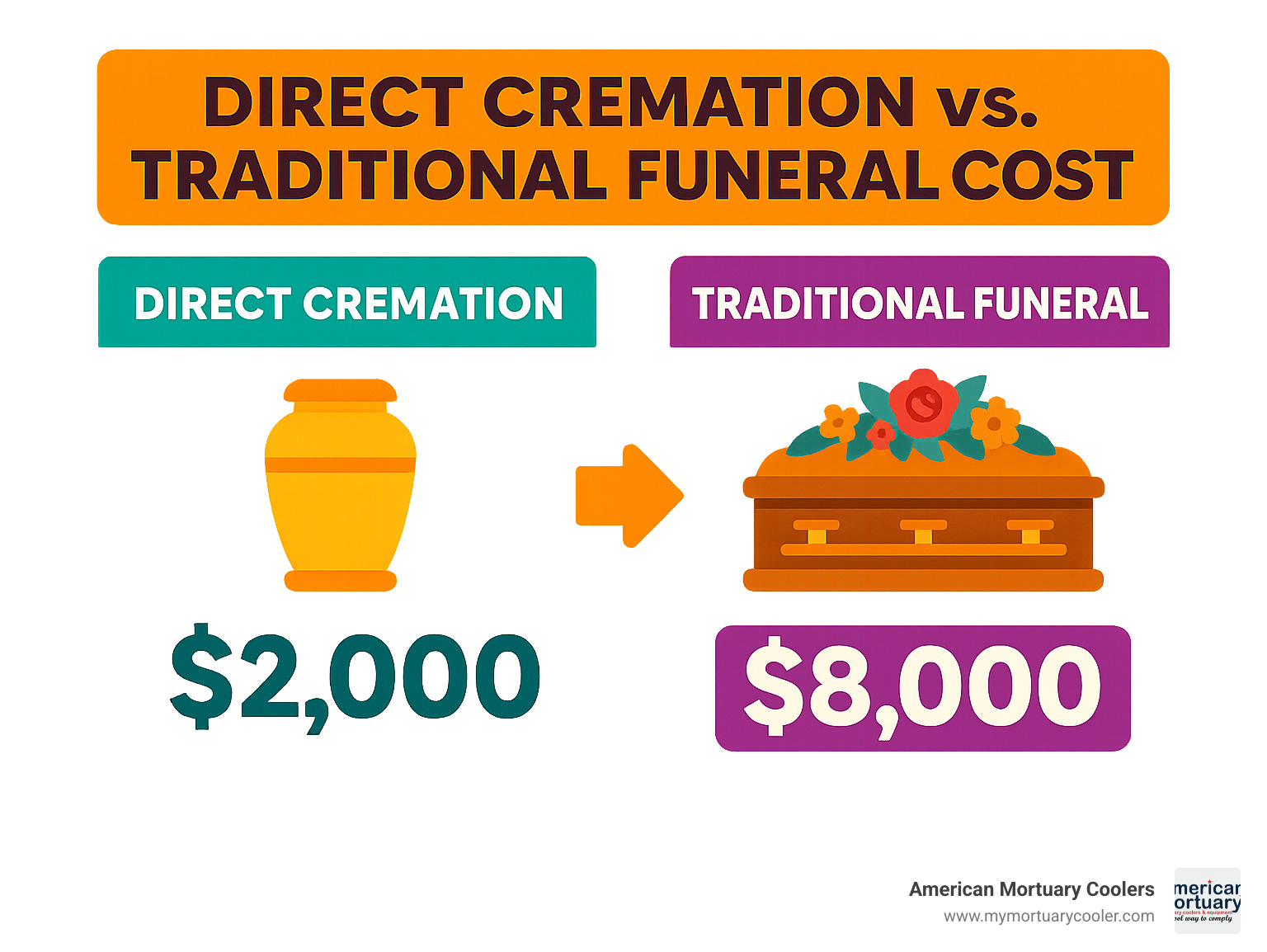
For more on the benefits of direct cremation, see this guide.
Direct Burial for Immediate Interment
Direct burial is the second most common option. It means:
- No embalming or public viewing
- The body is placed in a simple casket or container
- Burial occurs as soon as legal paperwork is completed, often within 24-48 hours
Direct burial is often chosen for religious reasons or when simplicity is preferred. Families may opt for a graveside service at a later date.
Alternative & Green Direct Disposition Methods
As environmental awareness grows, more families seek eco-friendly alternatives. These include:
- Alkaline Hydrolysis (Water Cremation): Uses water and alkali solution to break down remains, leaving bone ash similar to cremation. Legal in some states.
- Natural Organic Reduction (Human Composting): Transforms remains into soil. Gaining legal acceptance in select states like Washington and Colorado.
- Whole-Body Donation: Donating the body to science or medical research, after which remains are often returned for cremation or burial.
For more on green funerals and human composting, see this guide.
Who Provides Direct Disposition Services?
- Funeral Homes: Offer direct disposition alongside full-service funerals; often provide the most support and options.
- Cremation Societies: Specialize in affordable, no-frills direct cremations and burials. Facilities may be basic but efficient.
- Direct Disposal Facilities: Focus exclusively on direct disposition, often at the lowest cost.
Be sure to compare providers for service range, facilities, and pricing—especially if you need family support or additional options like viewing.
Planning, Paperwork, and Timing: How the Direct Disposition Process Works
When a death occurs, direct disposition moves quickly but follows a careful sequence that balances legal requirements with respectful care. Understanding this process helps families know what to expect during an already difficult time.
The entire timeline typically spans 24-48 hours from death to final disposition, though this can vary based on paperwork requirements and facility availability. Let me walk you through each step of how this streamlined process actually works.
Step 1: Body Removal and Initial Care
Once death is officially pronounced by a medical professional, the process begins immediately. A licensed provider—whether that's a funeral home, cremation society, or hospital staff—handles the careful removal of the deceased.
The body is then transported to a facility equipped with proper refrigeration and storage capabilities. This isn't just about logistics; it's about maintaining dignity while meeting health department requirements. Every step requires licensed professionals who understand both the legal obligations and the emotional weight of their work.
Refrigeration & Care Before Final Disposition
Proper refrigeration forms the backbone of respectful direct disposition. Most states require refrigeration when disposition isn't immediate and embalming hasn't been performed—and for good reason.
Mortuary coolers are specialized refrigeration units designed specifically for this purpose. They maintain precise temperatures that meet health codes while preserving the dignity of the deceased. These aren't ordinary refrigeration units; they're purpose-built to handle the unique requirements of mortuary care.
At American Mortuary Coolers, we've spent years perfecting custom mortuary coolers for funeral homes and facilities nationwide. Our equipment ensures that remains are handled with the respect, safety, and compliance that families deserve during this process.
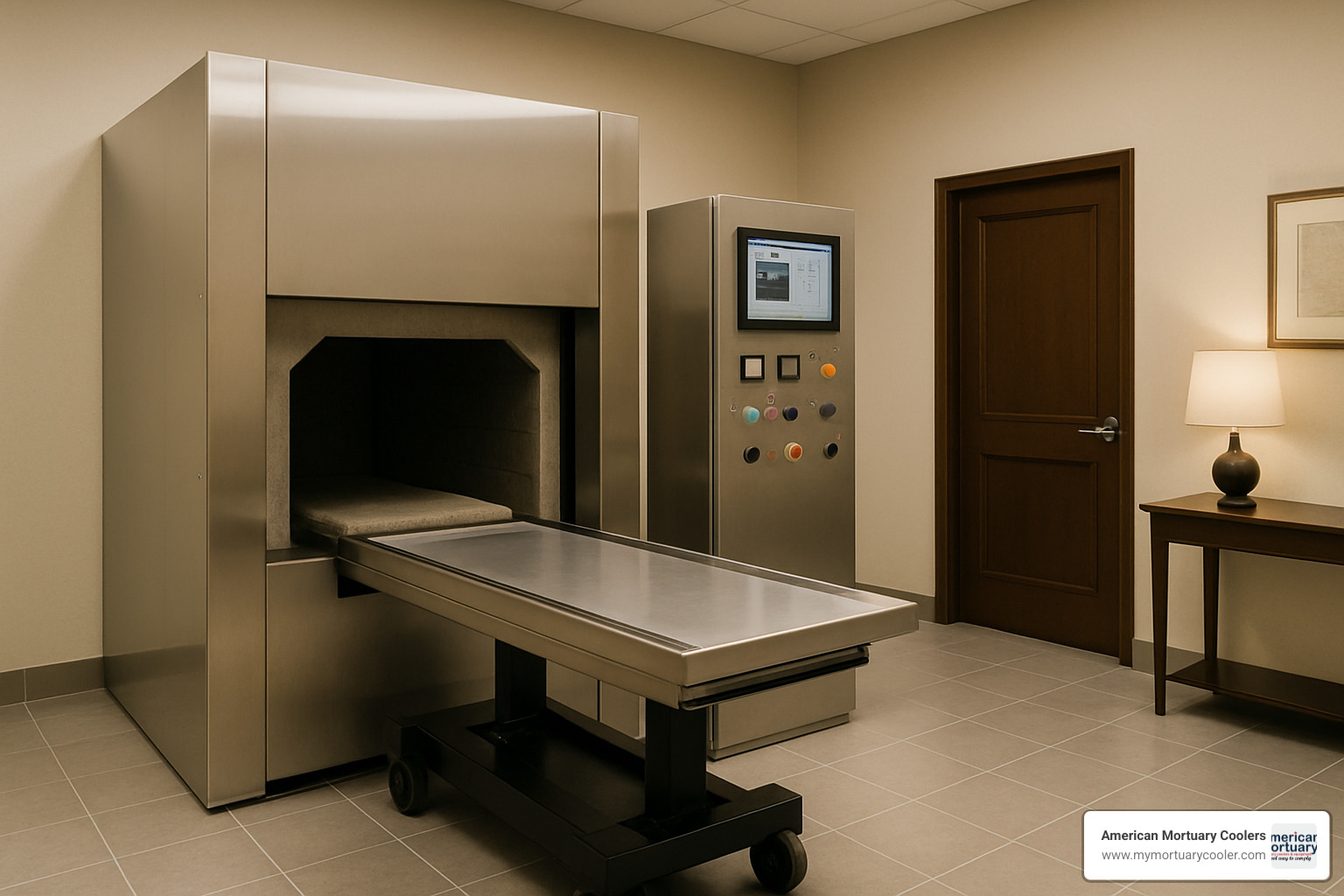
Learn more about cremation chambers and proper refrigeration.
Step 3: Paperwork and Authorizations
While the body is being properly cared for, the necessary paperwork moves forward simultaneously. This includes obtaining certified copies of the death certificate, securing burial-transit permits or cremation authorization forms, and completing any additional documentation required for alternative disposition methods.
The beauty of direct disposition is that this paperwork process is streamlined compared to traditional funeral arrangements. There's no need to coordinate viewing schedules, ceremony details, or elaborate transportation arrangements. Everything focuses on the essential legal requirements.
Step 4: Final Disposition
The final step varies depending on the chosen method. For cremation, the body is placed in a basic container and the cremation process begins. The cremated remains are then returned to the family in a simple container or chosen urn.
For direct burial, the body is placed in a simple casket or container and interred at the chosen cemetery location. The entire process maintains simplicity while ensuring all legal and health requirements are met.
Can You View the Body Before Direct Disposition?
Many families wonder if they can still say goodbye even with direct disposition. The answer is often yes, though options are more limited than with traditional funeral services.
Private identification viewings are frequently possible at the facility, usually without embalming. These brief, private moments allow immediate family members to have closure without the formality of a traditional viewing.
Some providers may offer embalming as an optional service if families need more time or want to accommodate out-of-town relatives. However, this isn't required and does add to the overall cost.
Always discuss viewing options with your chosen provider. Policies vary between facilities, and some may offer simple, dignified spaces for these private goodbyes.
Coordinating a Memorial After the Fact
One of the greatest advantages of direct disposition is the flexibility it provides for memorial planning. Families can take time to plan a celebration of life whenever and wherever feels right—whether that's at home, at a meaningful location, or even in a virtual format.
Scattering ceremonies have become particularly popular among families who choose direct cremation. These can be intimate family gatherings or larger celebrations, planned for a time when emotions have settled and travel arrangements can be made thoughtfully.
Livestreamed memorials offer another modern option, especially helpful for connecting with relatives and friends who live far away. Graveside services can also be held after a direct burial, allowing families to gather when they're ready.

Cost, Benefits, and Emotional Impact
When families face the difficult task of making end-of-life arrangements, direct disposition offers a path that can ease both financial stress and logistical complexity. However, understanding the full picture—including potential emotional considerations—helps families make the best choice for their unique situation.
Comparing Costs: Direct Disposition vs. Traditional Funeral
The numbers speak for themselves: direct disposition typically costs 40-60% less than traditional funeral services. This significant savings can provide much-needed relief during an already challenging time.
Here's what families can expect to pay:
Direct cremation averages $1,000 to $2,500 nationwide, while direct burial ranges from $1,500 to $3,000 (not including the cemetery plot). Compare this to traditional funerals with burial, which often cost $7,000 to $12,000 or more.
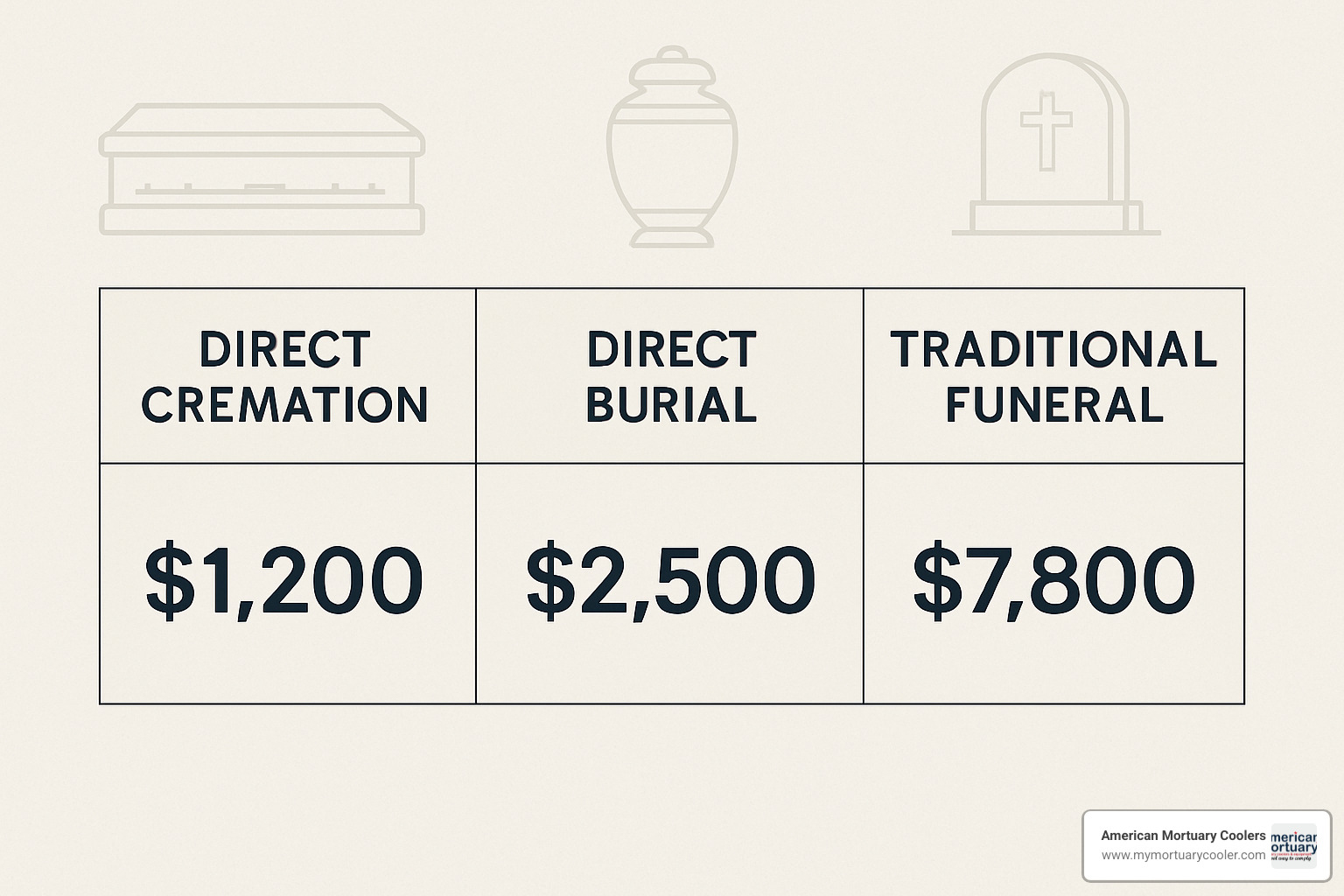
What makes direct disposition so affordable? The package typically includes removal and transportation of the deceased, basic refrigeration using mortuary coolers for proper storage, all necessary permits and paperwork, a basic casket or container, and return of remains for cremation services.
Families can add optional services like private viewing, upgraded urns or caskets, obituary notices, and memorial service coordination. But the base package covers everything legally required for a dignified disposition.
The value goes beyond just dollars saved. Many families appreciate avoiding the pressure of making numerous decisions about flowers, music, and ceremony details during their time of grief.
Direct Disposition and Grief: Balancing Emotional Needs
While direct disposition simplifies the practical aspects of death care, it's important to acknowledge that some families may feel they're missing important emotional rituals. Traditional funeral ceremonies have evolved over centuries to help people process loss and say goodbye.
The absence of visitations, formal ceremonies, and funeral processions can sometimes leave family members feeling like something is incomplete. This doesn't mean direct disposition is wrong—it just means families need to be thoughtful about addressing their emotional needs in other ways.
Many families find creative solutions that work better for their specific situation. Organizing a memorial or celebration of life separately allows for more personalized tributes and gives people time to plan something truly meaningful. Virtual gatherings and online tributes can connect far-flung family members and friends who couldn't attend a traditional service anyway.
Some families find that removing the immediate pressure of funeral planning actually allows them to focus more on healing and remembrance. Without the stress of coordinating a large event during the first days of grief, they can take time to process their loss more naturally.
If you're concerned about the emotional impact, grief support resources and counseling are available in most communities. Many people find that talking through their feelings with a professional helps them steer this difficult time, regardless of what type of disposition they choose.
Special Considerations for Veterans & Service Members
Military families have unique rights and benefits that can make direct disposition both more affordable and more meaningful. The Person Authorized to Direct Disposition (PADD) has special authority to arrange military honors and select the most appropriate burial or cremation method for their loved one.
Eligible veterans can receive military honors including honor guard ceremonies, burial flags, and possible reimbursement for funeral or direct disposition expenses. These benefits can significantly offset costs while ensuring the service member receives appropriate recognition.
Veterans cemeteries offer burial or inurnment at no cost or reduced rates, making direct burial an especially attractive option for military families. The combination of military benefits and direct disposition can provide both dignity and affordability.
At American Mortuary Coolers, we've worked with many funeral homes serving military families. Our custom mortuary coolers ensure that veterans receive the same respectful care and proper refrigeration as any other family, maintaining dignity throughout the direct disposition process.
For specific information about military benefits and eligibility, contact your local VA office or military support resources. They can help you understand exactly what benefits are available and how to coordinate them with your chosen disposition method.
Frequently Asked Questions about Direct Disposition
When families are considering direct disposition, they often have practical questions about how the process works and what to expect. Here are the most common concerns I hear from families, along with straightforward answers to help you make informed decisions.
How Can I Ensure My Direct Disposition Wishes Are Honored?
The best way to guarantee your wishes are followed is to put them in writing and communicate clearly with your loved ones. Advance directives are legal documents that spell out exactly what you want—whether that's direct cremation, direct burial, or another form of direct disposition.
Pre-planning takes this a step further. You can arrange and even pay for services in advance with a reputable provider. This removes the financial burden from your family and ensures everything happens exactly as you want it.
Consider appointing a designated agent or Person Authorized to Direct Disposition (PADD) if you're in the military. This person will have the legal authority to carry out your wishes, even if family members disagree.
The key is clear communication. Include your wishes in your will, discuss them with family members, and keep all documentation in an easily accessible place. This prevents confusion and family disputes during an already difficult time.
Can Family Members Still View the Body?
Yes, but the options are more limited than with traditional funeral services. Most providers offering direct disposition can arrange private identification viewings at their facility. These are typically brief, simple visits without the formal setup of a traditional visitation.
Embalming isn't required for direct disposition, but some facilities may offer it if you need more time or want to allow out-of-town relatives to say goodbye. This will add to the cost and may delay the process.
Some modern facilities even offer virtual options—video calls or photographs that allow distant family members to participate in their own way. While this might sound unusual, many families find it surprisingly meaningful.
Always ask your provider about their viewing policies and facility setup. Some have comfortable family rooms, while others may only offer basic identification areas.
What Is Included in a Typical Direct Disposition Package?
Most direct disposition packages cover the essential services needed to handle your loved one's remains respectfully and legally. Transportation from the place of death is always included—whether that's a hospital, home, or care facility.
Refrigeration in a mortuary cooler is a crucial component that ensures proper care while paperwork is completed. At American Mortuary Coolers, we've seen how important quality refrigeration equipment is for maintaining dignity throughout the process.
The package typically includes a basic container—either a simple casket for burial or a combustible container for cremation. All required permits and paperwork are handled by the provider, including death certificates and burial-transit permits.
For cremation, you'll receive the ashes returned in a basic container or temporary urn. For burial, the service is complete once interment happens at the cemetery.
Upgrades are usually available for families who want them—things like memorial service planning, upgraded urns or caskets, obituary assistance, or keepsake items. These add-ons give you flexibility to personalize the experience while keeping the basic service simple and affordable.
Conclusion
When a family is facing loss, the last thing they need is complicated arrangements and overwhelming costs. Direct disposition offers a path that honors dignity while embracing simplicity—letting families focus on what truly matters during their time of grief.
Throughout this guide, we've explored how direct disposition has become more than just an alternative—it's a thoughtful choice that reflects changing values around end-of-life care. Whether through direct cremation, direct burial, or emerging green options like human composting, families now have meaningful ways to say goodbye that align with their beliefs, budgets, and emotional needs.
The benefits are clear: 40-60% cost savings compared to traditional funerals, faster timelines that reduce prolonged stress, and the flexibility to create personalized memorials when and where they feel right. But perhaps most importantly, direct disposition removes the pressure of immediate decision-making, giving families space to grieve and heal.
At American Mortuary Coolers, we've witnessed how proper equipment makes all the difference in maintaining dignity throughout the direct disposition process. Our custom mortuary coolers ensure that every step—from initial care through final disposition—meets the highest standards of respect and compliance.
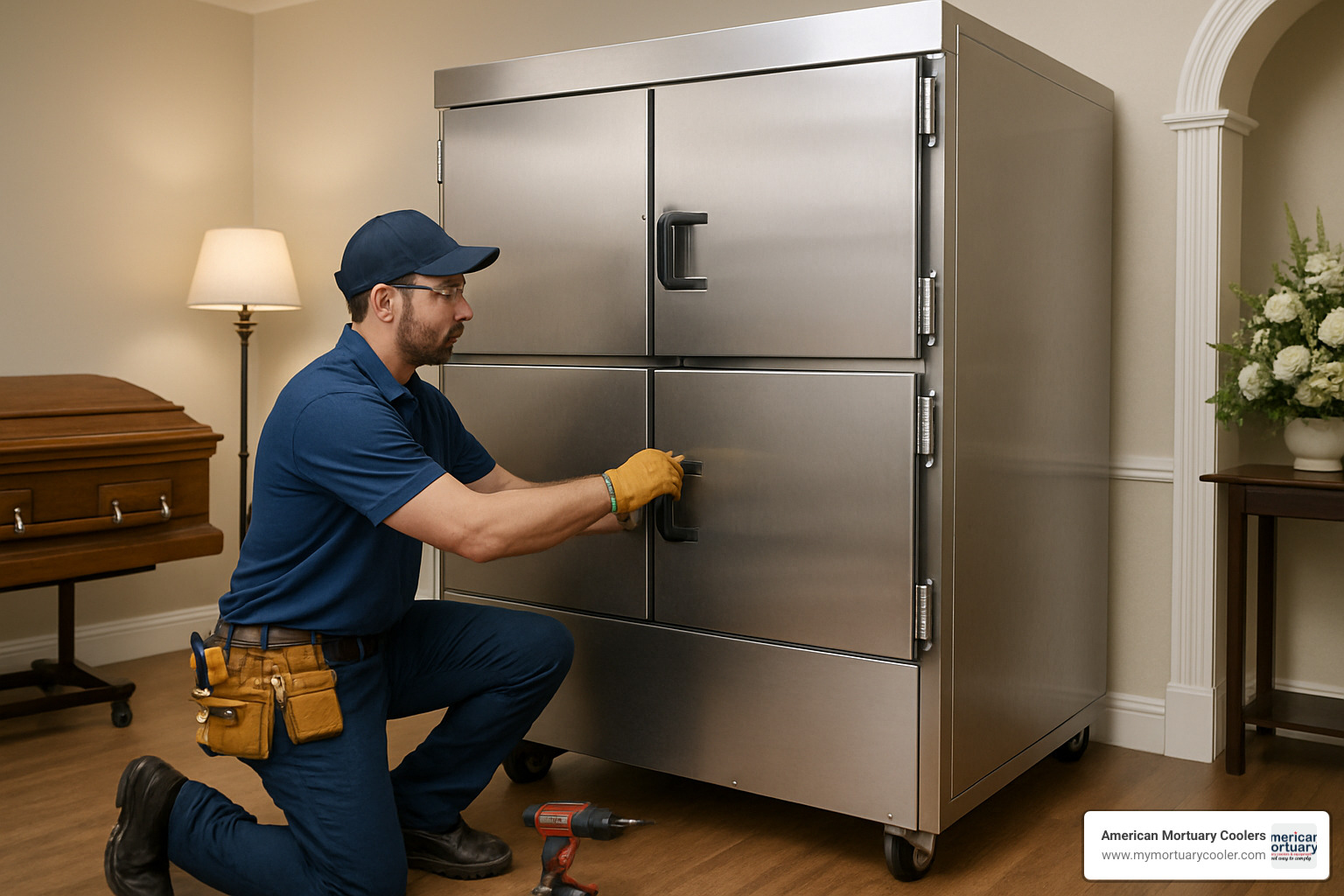
We're proud to support funeral homes and direct disposition providers across all 48 contiguous states with durable, custom solutions delivered directly to your location. When funeral professionals have the right mortuary cooler equipment, families can trust that their loved ones are being cared for with the utmost respect—even in the streamlined direct disposition process.
Whether you're a funeral director seeking reliable equipment or a family planning ahead, understanding your options brings peace of mind. Direct disposition isn't about cutting corners—it's about cutting through unnecessary complexity to focus on what matters most: honoring a life well-lived.

For more on our mortuary cooler solutions and how we support the direct disposition process, see our latest guide.
Related Reading:
- More info about eco-friendly options
- A comprehensive guide to human composting options
- The benefits of choosing direct cremation
Locations served: Johnson City TN, Atlanta GA, Chicago IL, Columbia SC, Dallas TX, Los Angeles, New York NY, Pittsburgh PA, Midwest Region, Northeast Region, Rocky Mountain Region, Southeast Region, Southwest Region, Pacific Region, and more. We deliver nationwide—contact us for custom solutions.



